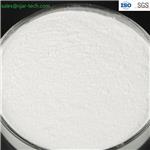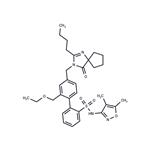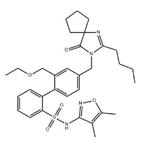Sparsentan (PS-433540, RE-021, DARA) is a dual endothelin type A receptor(ETA) and angiotensin II type 1 receptor antagonist.
RE 201 is used an Endothelin A receptor antagonist used in the treatment of hypertension.
Sparsentan (RE-021) is a selective dual-acting receptor antagonist with affinity for endothelin (A type) and angiotensin II receptors (Type 1). Sparsentan combines the active moieties of the selective AT1 receptor antagonist irbesartan and a selective ETA receptor antagonist.
Sparsentan (RE-021) is a highly potent dual angiotensin II and endothelin A receptor antagonist with Kis of 0.8 and 9.3 nM, respectively.
Common side effects of Sparsentan include swelling of the hands, legs, ankles and feet; dizziness; and low red blood cells (anaemia).
Serious side effects of Sparsentan include hives; difficulty breathing; swelling of the face, lips, tongue, or throat; nausea; vomiting; stomach pain (upper right side); tiredness; loss of appetite; yellowing of the skin or eyes (jaundice); dark urine; fever; itching; severe birth defects low blood pressure; dizziness; lightheadedness; fainting; muscle cramps; dry skin; shortness of breath; trouble sleeping; frequent urination; little or no urination; abnormal blood test results (increased potassium); unusual weight gain and swelling of the ankles or legs.
Sparsentan dose dependently antagonizes the angiotensin II-induced pressor response with an ED50 value of 0.8 μmol/kg iv and 3.6 μmol/kg po. Sparsentan also shows efficacious and long acting in the big ET-1-induced pressor model. Sparsentan causes a significant lowering of blood pressure at the lowest dose tested (10 μmol/kg/day) in spontaneously hypertensive rats. Sparsentan shows good oral bioavailability in rats, dogs, and monkeys, averaging 40%, 86%, and 21% F, respectively. At 100 μmol/kg/day, Sparsentan reduces the blood pressure from 170 to less than 100 mmHg during the course of the drug’s pharmacokinetic duration. Sparsentan at 100 μmol/kg/day essentially converts the spontaneously hypertensive rats into normotensive rats during the course of its pharmacokinetic duration.



